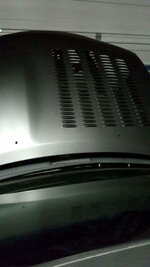TSiAWD666
Supporting Vendor
- 2,648
- 899
- Aug 15, 2003
-
Herndon,
Virginia
I got only a couple things to say here:
1) Bend the dipstick away from that manifold. You do still have an o-ring in there you don't want degrading quickly from excess heat and it looks like you're touching that bag. Air's a wonderful insulator. Physical contact results in conduction which is a wonderful way to transfer heat around.
2) Please add some sort of clamp to the dipstick to hold it in place. I swear I've told you this a thousand times. I don't know if it's your obsession with looking stock or not but you never ever ever want to have that pop loose and squirt oil on that ridiculously hot area as it will instantly start a fire and there goes your overly meticulous car.
3) It's good that the wastegate lines are done but are you sure these melted not because you didn't have heat shielding on them but because those lines were a cheap low temp material? Where did they melt exactly? Was it the point of contact with the wastegate (which gets incredibly hot, even in the upper half)? A set of silicone lines unshielded would have been just fine here and a lot cheaper. Better be sure the new material is up to snuff and not assume the heat shielding will save the day.
1) Bend the dipstick away from that manifold. You do still have an o-ring in there you don't want degrading quickly from excess heat and it looks like you're touching that bag. Air's a wonderful insulator. Physical contact results in conduction which is a wonderful way to transfer heat around.
2) Please add some sort of clamp to the dipstick to hold it in place. I swear I've told you this a thousand times. I don't know if it's your obsession with looking stock or not but you never ever ever want to have that pop loose and squirt oil on that ridiculously hot area as it will instantly start a fire and there goes your overly meticulous car.
3) It's good that the wastegate lines are done but are you sure these melted not because you didn't have heat shielding on them but because those lines were a cheap low temp material? Where did they melt exactly? Was it the point of contact with the wastegate (which gets incredibly hot, even in the upper half)? A set of silicone lines unshielded would have been just fine here and a lot cheaper. Better be sure the new material is up to snuff and not assume the heat shielding will save the day.




















